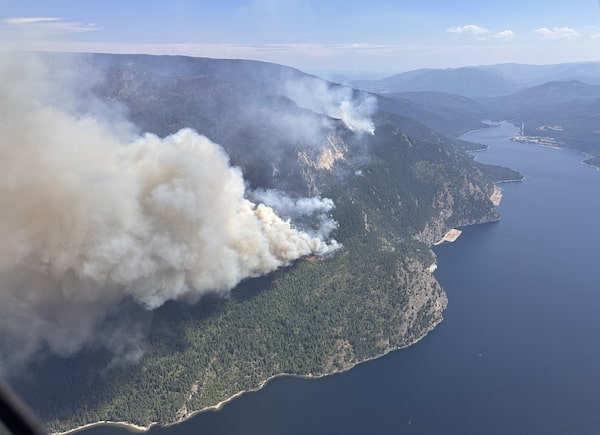
The Lower East Adams Lake wildfire in B.C.'s Shuswap region.HO/The Canadian Press
As B.C. braced this weekend for a heat wave, Canadian Armed Forces personnel were expected to head to the Northwest Territories to help fight wildfires, highlighting the impact of an unprecedented wildfire season, both in area burned and equipment and personnel pressed into service to try to control it.
The B.C. government on Saturday warned people throughout the province to prepare for higher temperatures expected to kick in Sunday, urging people to identify places they could escape the heat, including movie theatres, shopping malls and community cooling centres.
Many local governments, including those in Kamloops, Chilliwack and Burnaby, posted online statements that cooling centres were expected to stay open until the heat event is over.
B.C.’s stretch of hot weather is expected to last until Saturday. Temperatures are not expected to reach the extremes seen during the heat dome of 2021, when Lytton, B.C., hit a record 49.6 C on June 29. But high temperatures, especially over a prolonged period, are linked to higher risk of heat-related illness, the province said in a Saturday statement.
On the wildfire front, evacuation orders have been issued for several communities along the boundary between Alberta and the Northwest Territories.
What’s the difference between an evacuation alert and an evacuation order in Canada?
The town of Fort Smith, NWT, posted an evacuation order on Saturday. That day, the Regional Municipality of Wood Buffalo posted an evacuation order for Fort Fitzgerald, a hamlet along the Slave River in Alberta. An evacuation order is also in place for Smith’s Landing First Nation, the municipal notice said.
Authorities had been warning that Highway 5 into Fort Smith could be shut as nearby fires continued to burn, and on Sunday afternoon the territory’s infrastructure department said the route was no longer open.
Federal Emergency Preparedness Minister Harjit Sajjan in a social-media post Saturday said Canadian Armed Forces (CAF) would be deployed to help tackle wildfires in the NWT.
The support is set to begin on Tuesday and run until Aug. 29, National Defence spokesperson Jessica Lamirande said Sunday in an e-mail.
Soldiers will be drawn from the 2nd Canadian Division, based out of CFB Valcartier in Quebec, with training for the deploying troops to take place in Valcartier in the coming days.
An advance reconnaissance team is already on the ground in Yellowknife and co-ordinating with the NWT government, Ms. Lamirande said.
CAF personnel will help with firefighting and logistical support and provide aircraft for evacuations and moving personnel and equipment, she added.
The federal assistance to the NWT comes as provincial, municipal and Indigenous governments are under pressure to help communities recover from past disasters or extreme weather events, including floods, hurricanes and wildfires, and be better prepared for such events in the future.
The B.C. government in June announced it would spend $10-million to provide free air-conditioning units to people who are “medically vulnerable” and have low incomes, saying the new funds were expected to result in 8,000 units being installed over the next three years.
Critics say that number falls short of what is required to protect those who are most vulnerable during heat waves. There has also been confusion over program regulations, including whether landlords can block tenants from seeking to have units installed.
As of Aug. 4, BC Hydro had installed more than 360 units, spokesperson Kyle Donaldson said Sunday in an e-mail. About 3,000 applications have been received to date, of which about 2,000 have been approved and are in progress, he said, adding that BC Hydro has a goal of installing up to 1,000 units a month as part of the three-year program.
“We want to assure applicants we are committed to installing these units,” Mr. Donaldson said, adding that eligible applicants can apply online or by mail.
A 2022 coroner’s report on the heat dome that enveloped much of the province in June, 2021, resulting in the deaths of 619 people, found more than 80 per cent of those who died were on three or more chronic-disease registries; 67 per cent were aged 70 or older; and those with mental-health or substance-use disorders were at higher risk for death. Almost all deaths, 98 per cent, occurred indoors, and 56 per cent of those who died lived alone.
B.C. is also experiencing severe drought conditions, which increase the risk of wildfire. The province measures drought on a zero-to-five scale, with Level 5 indicating that adverse impacts on communities and ecosystems are almost certain.
As of Thursday, most of B.C.’s 34 water basins were at Level 4 or Level 5, according to the provincial drought information website.
With reports from The Canadian Press
 Wendy Stueck
Wendy Stueck